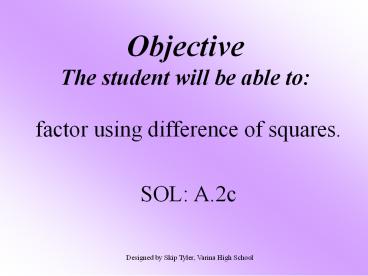Objective The student will be able to: - PowerPoint PPT Presentation
Title:
Objective The student will be able to:
Description:
Designed by Skip Tyler, Varina High ... prime. 2(9c2 4d2) 2(3c 2d)(3c 2d) 2(3c 2d)(3c 2d) ... prime (2m 8)(2m 8) 4(-16 m2) 4(m 4)(m 4) ... – PowerPoint PPT presentation
Number of Views:45
Avg rating:3.0/5.0
Title: Objective The student will be able to:
1
ObjectiveThe student will be able to
factor using difference of squares. SOL A.2c
Designed by Skip Tyler, Varina High School
2
Factoring ChartThis chart will help you to
determine which method of factoring to use.
Type Number of Terms
- 1. GCF 2 or more
- 2. Difference of Squares 2
3
Determine the pattern
- 1
- 4
- 9
- 16
- 25
- 36
12 22 32 42 52 62
These are perfect squares! You should be able to
list the first 15 perfect squares in 30 seconds
Perfect squares1, 4, 9, 16, 25, 36, 49, 64, 81,
100, 121, 144, 169, 196, 225
4
Review Multiply (x 2)(x 2)
Notice the middle terms eliminate each other!
x2
- First terms
- Outer terms
- Inner terms
- Last terms
- Combine like terms.
- x2 4
x -2
x
2
2x
-2x
x2
-2x
-4
2x
-4
This is called the difference of squares.
5
Difference of Squares
- a2 - b2 (a - b)(a b)or
- a2 - b2 (a b)(a - b)
- The order does not matter!!
6
4 Steps for factoringDifference of Squares
- 1. Are there only 2 terms?
- 2. Is the first term a perfect square?
- 3. Is the last term a perfect square?
- 4. Is there subtraction (difference) in the
problem? - If all of these are true, you can factor using
this method!!!
7
1. Factor x2 - 25
- When factoring, use your factoring table.
- Do you have a GCF?
- Are the Difference of Squares steps true?
- Two terms?
- 1st term a perfect square?
- 2nd term a perfect square?
- Subtraction?
- Write your answer!
No
x2 25
Yes
Yes
Yes
-
Yes
( )( )
5
x
x
5
8
2. Factor 16x2 - 9
- When factoring, use your factoring table.
- Do you have a GCF?
- Are the Difference of Squares steps true?
- Two terms?
- 1st term a perfect square?
- 2nd term a perfect square?
- Subtraction?
- Write your answer!
No
16x2 9
Yes
Yes
Yes
-
Yes
(4x )(4x )
3
3
9
3. Factor 81a2 49b2
- When factoring, use your factoring table.
- Do you have a GCF?
- Are the Difference of Squares steps true?
- Two terms?
- 1st term a perfect square?
- 2nd term a perfect square?
- Subtraction?
- Write your answer!
No
81a2 49b2
Yes
Yes
Yes
-
(9a )(9a )
7b
7b
Yes
10
Factor x2 y2
- (x y)(x y)
- (x y)(x y)
- (x y)(x y)
- (x y)(x y)
Remember, the order doesnt matter!
11
4. Factor 75x2 12
- When factoring, use your factoring table.
- Do you have a GCF?
- 3(25x2 4)
- Are the Difference of Squares steps true?
- Two terms?
- 1st term a perfect square?
- 2nd term a perfect square?
- Subtraction?
- Write your answer!
Yes! GCF 3
Yes
3(25x2 4)
Yes
Yes
Yes
-
3(5x )(5x )
2
2
12
Factor 18c2 8d2
- prime
- 2(9c2 4d2)
- 2(3c 2d)(3c 2d)
- 2(3c 2d)(3c 2d)
You cannot factor using difference of squares
because there is no subtraction!
13
Factor -64 4m2
- prime
- (2m 8)(2m 8)
- 4(-16 m2)
- 4(m 4)(m 4)
Rewrite the problem as 4m2 64 so the
subtraction is in the middle!































